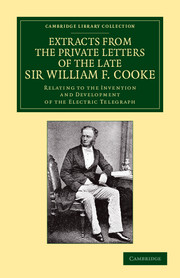
-
Select format
-
- Publisher:
- Cambridge University Press
- Publication date:
- August 2013
- March 2013
- ISBN:
- 9781139381147
- 9781108052740
- Dimensions:
- Weight & Pages:
- Dimensions:
- (216 x 140 mm)
- Weight & Pages:
- 0.14kg, 104 Pages
You may already have access via personal or institutional login
Book description
Originally a maker of wax anatomical models, William Fothergill Cooke (1806–79) became aware of the new electric telegraph while he studied anatomy in Germany. Hoping initially for a return of perhaps a hundred pounds from the English railway companies, he abandoned his studies and turned his attention to the commercial development of the technology, which, though demonstrable in laboratory conditions, was still little understood. Because the process relied on secrecy and many different clockmakers and engineers, it soon became so fraught that Cooke almost gave up before its completion. However, after receiving the encouragement of Michael Faraday and joining forces with Charles Wheatstone, Cooke finally brought his plans to fruition and eventually set up the Electric Telegraph Company in 1846. First published in 1895, this book includes a selection of his private letters, written as he worked and often movingly uncertain, as well as a short memoir.
Contents
Metrics
Altmetric attention score
Full text views
Full text views help Loading metrics...
Loading metrics...
* Views captured on Cambridge Core between #date#. This data will be updated every 24 hours.
Usage data cannot currently be displayed.
Accessibility standard: Unknown
Why this information is here
This section outlines the accessibility features of this content - including support for screen readers, full keyboard navigation and high-contrast display options. This may not be relevant for you.
Accessibility Information
Accessibility compliance for the PDF of this book is currently unknown and may be updated in the future.

